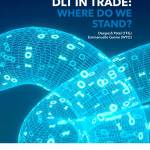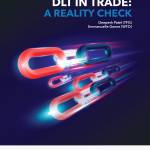Using blockchain for trade finance: an overview of the technology fundamentals

Contents
You don’t need to know the physics behind an internal combustion engine to drive a car – but if you’re going to drive one, it never hurts to have a bit of knowledge of what’s going on under the hood.
The same is true when it comes to working with blockchain technology: you may never fully understand all the minute intricacies, but knowing some fundamentals can help you navigate the space.
What better place to start than with a definition: a blockchain is a cryptographically authentic, shared, distributed ledger.
To help understand what this actually means, let’s examine each of these key facets in more detail.
You don’t need to know the physics behind an internal combustion engine to drive a car – but if you’re going to drive one, it never hurts to have a bit of knowledge of what’s going on under the hood.
The same is true when it comes to working with blockchain technology: you may never fully understand all the minute intricacies, but knowing some fundamentals can help you navigate the space.
What better place to start than with a definition: a blockchain is a cryptographically authentic, shared, distributed ledger.
To help understand what this actually means, let’s examine each of these key facets in more detail.
A few core concepts
Before exploring cryptographic authenticity there are three core concepts that we need to be familiar with: public/private key cryptography, hash functions, and tokenisation.
Public/private key cryptography
This is the type of cryptographic security that most of the internet uses.
It ensures authenticity by assigning each digital entity two mathematically related values, referred to as public and private keys.
Algorithms use a concept called modular arithmetic to create a relationship between these two values such that a message encrypted by either one can easily be decrypted by the other.
Furthermore, employing the notion of prime factorisation makes it possible for one of the keys – the public key – to be completely public without compromising the security of the private key.
This type of cryptography allows digital entities to verify their identity.
For example, Albert can encrypt a secret message using his private key and transmit it across the internet to his friend Bernice. If Bernice is able to unencrypt to message using Albert’s public key, she can verify that Albert was indeed the sender and not an attacker posing in his place.
Hash functions
Cryptographic hash functions map arbitrary length inputs into outputs of a short and fixed length, often referred to as a “hash”.
This means that any input will map to a fixed-length pseudo-unique hash, which often takes the form of a hexadecimal value.
Even a slight alteration to the input will produce a drastically different output – to the point where not even the best-trained algorithm would be able to identify from the outputs that two nearly identical inputs were related in any way.
There are many different hash functions, of which the best are designed to be one-way and collision resistant.
This means that, given a hash, it is infeasible to find an input mapping to that hash, and, given any input, it is infeasible to find another input that would map to the same hash.
A hash is often compared to a fingerprint as they are both unique identifiers for another entity.
Security experts have used hashes to maintain data integrity in digital formats for many years.
Suppose that you and I signed and agreed to a contract in 2004. We could have hashed this signed document and maintained a record of this hash alongside the document itself.
Now, if we go back to dispute this contract today, we have a means of verifying that the contract we are both looking at today is identical to the one that we signed in 2004.
All we need to do is take the hash of the current document and if it is the same as the hash that we have stored from the 2004 document. If the two match we know that it has not been altered in any way.
Tokenisation
Tokenisation is the process where a unique set of identifiers for an object are used as inputs and are hashed, allowing an object to effectively exist on a blockchain.
Tokens can be used for inherently “on-chain” entities or they can allow for “off-chain” entities to be represented on the blockchain.
Imagine your car.
It has a series of characteristics and identifiers that make it different from every other car on the market. Even the car that came off the assembly line directly before it has a different VIN number.
We could tokenise your physical car and place it on the blockchain by taking the hash of all of these unique identifiers.
This allows your car to “exist” on the blockchain in the form of a token that can be owned and transferred between users – similar to the ownership papers that you probably carry in your glove box.
In the future, we can confirm that the token represents the same physical car by taking these same unique identifiers and hashing them again.
If this hash matches the hash originally recorded then we know we are talking about the same car.
Cryptographically authentic
At its core, blockchain simply refers to a process of storing data.
Bits of data, often authenticated using public and private key signatures and referred to as transactions, are tokenised and grouped together into what is called a block.
This entire block of transactions is then itself tokenised, creating a hash for the specific block, called a “block signature”.
The hash of this block is recorded in the next block, which is itself tokenised using this same process.
What this does is creates a mathematical link between each block, which is where the image of a “block chain” originates.
If at any point, an attacker was to try and alter one of the transactions in a block, it would change the hash of that block.
As each block’s hash is stored in the subsequent block, such an attack would be easily detectable and openly rejected by the other nodes on the network.
As a result, the data storage is cryptographically secure.
It’s important to note that this is an example of just one method that a network can use to secure content. Many other protocols exist and innovators in the space are constantly iterating on these processes to create faster and more secure approaches.

Shared
Like every network, a blockchain network is subject to Metcalfe’s law, meaning that its useful value is directly and exponentially related to the number of entities that participate in it.
As such, using a blockchain structure for a centralised data store severely inhibits the potential value, which is why most of its applications are for decentralised systems.
In a decentralised system various actors, referred to as nodes, can read and submit transactions for the blockchain.
Other nodes have the power to validate these transactions, store them into blocks, and commit them to the permanent record (this process is referred to as “mining”).
The nodes that hold each of these privileges will depend on the type of blockchain (i.e., whether it is public or private; permissioned or permissionless; etc.) that is being employed in each instance.
Through the use of predefined consensus protocols, which differ for each network, all of the nodes in a network are able to have access to a single version of the truth, without the need to rely on third-party intermediaries.
This is done because the very nature of a blockchain system establishes trust using deterministic software rather than reputation or law.
Distributed
There is no single instance of a blockchain, but rather many replicas that are stored on each node in a network.
When a new block is verified according to the consensus protocol of the network, this block is transmitted out to all other nodes on the network, who then add it to their independent record of the blockchain.
An attempt to falsify or alter a transaction that is already committed to the chain would need to be done simultaneously on at least 51% of the network. The possibility of successfully accomplishing such a feat becomes increasingly negligible with each additional node that exists on the network.
Additionally, if any node were to attempt to transmit a new block that did not comply with the consensus protocol of the network, it would simply be ignored by the other nodes.
Ledger
At its core, a blockchain is no different than a simple accounting ledger in the sense that it records each transaction as it occurs.
In contrast to a traditional database, however, there is no “update” or “delete” function.
This means that, like an accounting ledger, a mistake can only be “corrected” by adding a new compensating transaction.
This means that there is no way to hide an event that has occurred by simply deleting it.
The tip of the iceberg
If you are still feeling a little confused, that’s okay – it’s a complicated topic that can take a while to wrap your head around.
If you think you’ve got a solid grasp on this and what to learn more, you’re in luck because there is heaps of information on the world wide web that dives into the murky depths of the esoteric blockchain world.
For our purposes in this guide, we are not going to focus on the technical aspects of the technology, but rather on some of the practical business applications that it can have for the trade finance industry.
After all, we don’t necessarily need to know the optimal firing pattern for crankshaft rotations in a six-stroke engine to know when it might be time to take the car into the shop for an oil change.
Publishing Partners
- Blockchain & DLT Resources
- Cryptocurrency Resources
- All Topics
- Podcasts
- Videos
- Resources
- Conferences
















